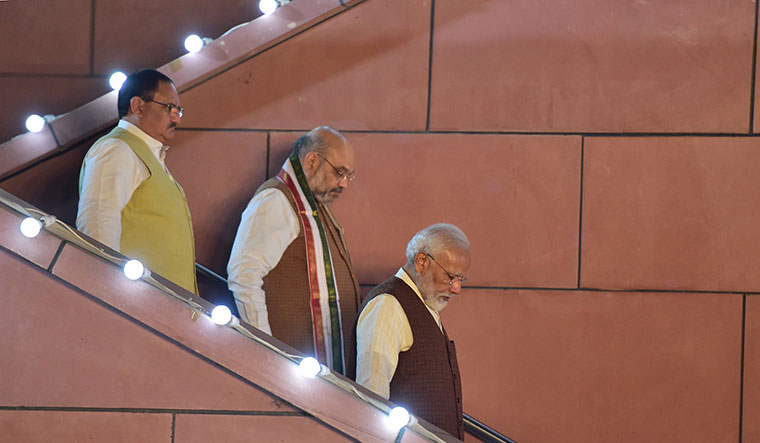WITH LOSSES IN THE RECENT state elections, the BJP’s dream of securing a majority in the Rajya Sabha has been pushed back. It is unlikely to be fulfilled during Prime Minister Narendra Modi’s current term. To build on its current tally of 93 seats in the 245-member house, the BJP would have to perform exceedingly well in next year’s Uttar Pradesh elections. This explains why the party’s focus has already shifted to the politically significant state.
The BJP was hoping that a win in Bengal would offset the losses in the upper house likely to happen because of its subpar performance in the 2018 Rajasthan and Chhattisgarh elections. However, the Trinamool won 213 of 294 constituencies, which means it would retain most of its seats in the upper house. The tenure of 77 Rajya Sabha members will end in 2022.
The BJP’s worries are manifold. The recent results have thrown up organisational challenges because of the strong cadre support for Chief Minister Mamata Banerjee; imports from the Trinamool were of little help. Before the BJP’s rise, the Rashtriya Swayamsevak Sangh had laid the foundation for the saffron party to emerge as the main opposition in Bengal. The RSS is now eager to grow that base as the massive mandate for Mamata, where Muslims consolidated behind her, also destroyed the Congress-Left front.
A similar consolidation of Muslims for the Congress-All India United Democratic Front alliance in Assam helped the BJP. However, it meant that the ruling BJP-Asom Gana Parishad combine did not have any Muslim members. None of its eight Muslim candidates won; the BJP reacted by quickly dissolving its minority cell in the state.
In the other states, though, the party has shied away from taking any action against any of its office bearers. There may not be immediate fixing of responsibility on local units as the campaigns were centrally managed. High-profile leaders such as Home Minister Amit Shah micro-managed the Bengal campaign, with veterans Kailash Vijayvargiya, Arvind Menon and Shiv Prakash building up the party machinery.
Even with the losses and the pandemic, the BJP has downplayed the need for a formal review. “Bengal is not a loss for us,” said party general secretary Tarun Chugh. “We improved our tally from three seats to 77.” Currently, though, some party leaders in West Bengal said their supporters needed a sense of security under Mamata’s rule. If the party fails to save BJP supporters from the Trinamool’s ire, many are likely to switch sides out of fear. And, the advantage it gained by becoming the main opposition party would be lost fast. Currently, the Modi government has been using its resources at the Centre and the BJP-RSS combo in the state is trying to stop violence.
Strategically, the BJP is looking at larger goals. Two of its winning candidates will vacate their Assembly seats and keep their Lok Sabha seats. The BJP did not want a bigger contest for the Lok Sabha elections.
The model that worked in Uttar Pradesh in 2017 did not work in Bengal. The entry of turncoats did not yield expected results, and the party did not do well enough in the reserved seats. It had expected that the dalits and tribals would have accepted the hindutva narrative, but it won only 39 of the 84 reserved seats. Given its 2019 haul, the party should have won more. Nevertheless, more than half of its total tally in Bengal came from these seats.
While the BJP was not hopeful of winning many seats in the southern states, Puducherry provided the saving grace. The Trinamool’s victory means that the party would have to work even harder to reach out to the people and keep its tag of being an “unchallenged political force” as it heads into elections in six BJP-ruled states in 2022—Uttar Pradesh, Gujarat, Himachal Pradesh, Uttarakhand, Goa and Manipur.
If the Uttar Pradesh victory in 2017 was the highlight of Modi’s first tenure, a victory in Bengal would have given the BJP a similar impetus in his second term. The results, however, have highlighted that the same electoral template will not work everywhere. And that the centralised approach in campaign management would run into roadblocks in the absence of strong local leaders. Also, the import of ideological turncoats could upset the BJP’s own dedicated and emotional cadre.
Party sources said the far bigger concern now was the BJP’s handling of the second wave of the pandemic; there is a growing perception that its leaders were missing in action. Even RSS chief Mohan Bhagwat said complacency had led to the second wave and the associated crisis. The RSS has launched its own measures to deal with the spreading virus and has prodded the BJP to ensure greater visibility on the ground.
Leaders of the BJP and the RSS, including Modi and party president J.P. Nadda, have held deliberations to devise a strategy to control the Covid-19 situation in Uttar Pradesh.
Nadda, in fact, has been holding almost daily meetings with office bearers across states, asking them to set up Covid-19 facilities, help people and be visible. But, as recent events have shown, the party has been on the defensive as the narrative has been slipping out of its hands. “The party leaders and workers should liaise better with the booth-level cadre. We should aim to provide help as soon as possible,” Nadda told his party leaders in a recent meeting.
With the pandemic wreaking havoc in rural areas, the BJP’s outreach, or the lack of it, will be remembered far more acutely than demonetisation or the Goods and Services Tax rollout.


